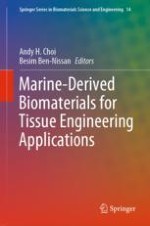2019 | OriginalPaper | Chapter
12. Sponge (Porifera) Collagen for Bone Tissue Engineering
Authors : Ming-Hao Zheng, Jessica Zheng
Published in: Marine-Derived Biomaterials for Tissue Engineering Applications
Publisher: Springer Singapore
Activate our intelligent search to find suitable subject content or patents.
Select sections of text to find matching patents with Artificial Intelligence. powered by
Select sections of text to find additional relevant content using AI-assisted search. powered by
